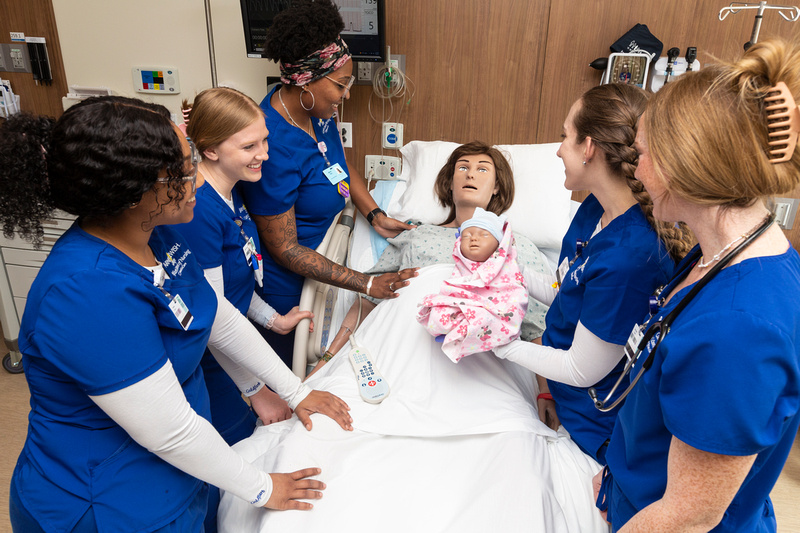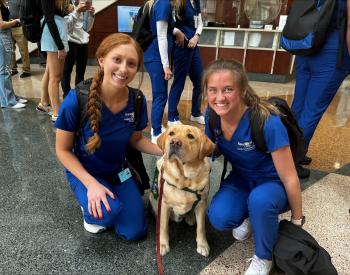

Technological Transformation Reimagines Nursing Education
To keep up with the changing healthcare world, nursing education is being reimagined at Barnes-Jewish College Goldfarb School of Nursing.
The College is leading a technological transformation by modernizing and expanding its existing nationally recognized Clinical Simulation Institute with state-of-the-art simulation labs and classroom environments.
After extensive staff training led by Clint Mettlach, director of simulation at the College, the labs opened for student education in April.
Real-World Experience in a Virtual World
The modernized environment will provide future nurses with an immersive, hands-on patient care experience using contemporary technology to simulate real-world patient care experiences.
"Providing a high-tech simulation environment allows us to attract high-caliber students from around the nation," Mettlach says. "Students will practice their skills with real-life demonstrations simulating the complexities and challenges of providing medical care to various types of patients."
The College's Clinical Simulation Institute includes a variety of simulation suites, including individual hospital rooms, an OB birthing suite, exam rooms, an operating room, and ward-style medical-surgical, and exam labs for training skills. All high-fidelity simulation suites are equipped with the latest audio/video camera systems, patient charting computers, diagnostic units and treatment equipment, staff carts, hospital beds with over-bed tables, and state-of-the-art patient simulators (manikins).
"We learned a lot working with our partner BJC HealthCare to create simulated patient rooms that mirror BJC hospital rooms," Mettlach says. "This means graduating nurses will walk into an environment they're familiar with. They're in training before they even get to the hospital to reduce the need for retraining."
High-tech, "high-fidelity," patient simulators allow students to practice everything from taking routine vital signs such as taking a pulse and blood pressure reading to delivering a baby. These patient simulators mimic human responses and appear to breathe, cough, cry, and speak, among other responses.
The Clinical Simulation Institute also includes virtual reality (VR) and mixed reality as learning tools. Students wearing VR goggles enter a completely virtual patient room where they interact with the patient, check vital signs, and can even provide CPR (cardiopulmonary resuscitation).
The most technologically advanced of all the simulation suites includes a birthing manikin and baby with augmented and mixed reality. Students wear high-tech goggles that show them a hologram of the birthing patient simulator and the baby. Through the goggles, students can see the structures and baby "inside" the mother as they deliver the baby. The baby makes realistic facial expressions and can cry.
Another suite includes a pediatric patient with an animatronic head and facial movement to help students develop the specialized skills needed to effectively communicate, diagnose and treat young patients.
In a separate glassed control room with monitors, educators use the simulation technology to stage hypothetical medical situations. They can change the health status of a patient simulator with a touch of a button. Through these simulations, students are immersed in a wide range of healthcare scenarios they may not see during traditional clinical experiences.
"Sometimes it's difficult to get a well-rounded clinical training experience, but in simulation, we know what the experiences will be because we can set up specific environments," Mettlach explains. "With our learning modalities, students have a chance to see and respond to situations as lead nurses not as students, yet it's in a safe learning environment. These simulated experiences are adding to clinicals, not replacing clinicals, to better prepare students for real-world experiences."
Focus on Inclusive Care
A key goal of the Clinical Simulation Institute technology upgrade is to improve diversity and cultural awareness for students. The patient simulators include a mix of race, sex, and age.
In different clinical scenarios, patient simulators are assigned a name, medical history, and condition, as well as a particular religious and cultural background.
Faculty and staff develop various scenarios that allow students to identify and respect different cultural needs so they become aware of them once they start working with real patients. As a result, students become more knowledgeable in providing care to a diverse patient population.
A New Generation of Learners
Mettlach says the way students learn has changed over the years. "Students today are comfortable learning through different modalities and using technology. Many play video games with virtual reality. Our Clinical Simulation Institute is changing the way nursing students learn. We make patient scenarios as realistic as possible with less pretending and more actual hands-on learning."
He says the renovated Clinical Simulation Institute has the most technology, space, and hands-on learning of any nursing school in the region.
"Our technology blows students away when they tour," Mettlach says. "They're amazed by how much time students get with hands-on learning."
The simulation labs are operational six days a week year-round to accommodate students in every program, including the Weekend and Evenings Option program. The simulation space is also used for continuing education for maintaining the clinical competencies of BJC providers.
Clinical simulation benefits both students and patients. Students will put their knowledge and skills into action before clinical rotations with real patients.
"Practicing and learning from mistakes in a simulated hospital environment keeps patients safer," Mettlach says. "Students also learn to prioritize multiple patients with complex needs, collaborate with multidisciplinary health care teams, and communicate with family members. as they develop increased competence and confidence. By the time they graduate, they will be better prepared to provide extraordinary care."
Donor Opportunities to Shape the Future
While BJC provided the capital expenditure for the renovated Clinical Simulation Institute, the College is seeking donor support for the future. Through The Foundation for Barnes-Jewish Hospital, donors may support an endowed fund to maintain the new technology or participate in commemorative naming opportunities at the Clinical Simulation Institute.
To help prepare the next generation of nurses or for information on touring the new simulation facilities, contact Pam Dempski at [MLL9] 314-362-2875 or email Pamela.Dempski@BJC.org or Marilyn Sheperd at 314-286-2241 or email Marilyn.Sheperd@BJC.org.
SIDEBAR: By the Numbers
The Clinical Simulation Institute at Barnes-Jewish College at Goldfarb School of Nursing includes:
- 20 med/surg beds
- 1 operating room suite
- 2 maternal and pediatric labs
- 3 skills lab beds
- 13 physical assessment lab bays
- 4 critical care simulation theater beds
- 2 patient exam rooms
- 2 adult labs
- 45 patient simulators
###
About Barnes-Jewish College Goldfarb School of Nursing
With a legacy beginning in 1902, Barnes-Jewish College has a strong tradition of educating healthcare professionals and leading evidence-based research. Students can pursue advancement through a variety of accredited undergraduate, graduate, and post-graduate nursing programs.
Barnes-Jewish College Goldfarb School of Nursing, part of BJC HealthCare, is located on the Washington University Medical Campus in St. Louis, home to Barnes-Jewish Hospital and St. Louis Children’s Hospital, with a second campus at Missouri Baptist Medical Center in St. Louis County.
Barnes-Jewish College has nationally recognized educational facilities with state-of-the-art classrooms, lecture halls, and sophisticated Clinical Simulation Institute labs with patient simulation manikins and exam rooms that provide high-tech, advanced nursing care experiences.
Barnes-Jewish College is accredited by the Higher Learning Commission (HLC), the Commission on Collegiate Nursing Education (CCNE), and the Council on Accreditation of Nurse Anesthesia Educational Programs. The College is fully approved by the Missouri State Board of Nursing and Missouri Coordinating Board for Higher Education (MCBHE). All clinical affiliates are Joint Commission for Accreditation of Healthcare Organizations (JCAHO) accredited.
Follow the Blog via Email
Enter your email address to follow this blog and receive notifications of new posts by email.
Follow the Blog via Email
Enter your email address to follow this blog and receive notifications of new posts by email.


